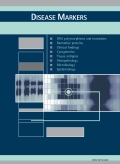Authors: Kanakis, Dimitrios | Lendeckel, Uwe | Theodosiou, Paraskevi | Dobrowolny, Henrik | Mawrin, Christian | Keilhoff, Gerburg | Bukowska, Alicia | Dietzmann, Knut | Bogerts, Bernhard | Bernstein, Hans-Gert
Article Type:
Research Article
Abstract:
ADAM 12 (meltrin alpha) belongs to a large family of molecules, consisting of members with both disintegrin and metalloproteinase properties. ADAMs have been implicated in several cell physiological processes including cell adhesion, cell fusion, proteolysis and signalling. ADAM 12 is widely expressed, including skeletal muscle, testis, bone, intestine, heart and kidney. In addition, a variety of tumours show elevated expression of ADAM12; among them being breast-, colon-, gastric- and lung-carcinoma. As to the brain,
…ADAM 12 has been shown previously to be expressed in rat and human oligodendrocytes. However, little is known about the expression of this protease in brain tumours. This study demonstrates the presence of ADAM 12 in non-neoplastic oligodendroglial cells of normal human brain as well as in neoplastic oligodendroglia and minigemistocytes arising from four pure oligodendrogliomas and three mixed oligoastrocytomas. Double stainings revealed a notable preference of ADAM 12 for the oligodendroglial over astroglial components. The results of immunohistochemistry are in accordance with the results obtained from the RT-PCR, which further demonstrated a mild difference concerning the mRNA concentration of ADAM 12 between similar grades of eight astrocytomas and eight oligodendrogliomas (namely four astrocytomas grade II versus four oligodendrogliomas grade II and four astrocytomas grade III versus four oligodendrogliomas grade III). Both cellular immunostaining for ADAM 12 and ADAM 12 mRNA content decrease with higher histologic grade of the tumour. Surprisingly, the latter parameter (ADAM12 mRNA) showed a significant opposite correlation to the degree of histologic tumour malignancy. From our data showing that ADAM 12 is highly expressed in, but not restricted to, oligodendrogliomas, we conclude that ADAM 12 immunohistochemistry may be a helpful tool in the diagnosis of brain tumours.
Show more
Keywords: ADAM 12, gliomas, oligodendrogliomas, immunohistochemistry, RT-PCR
DOI: 10.3233/DMA-120953
Citation: Disease Markers,
vol. 34, no. 2, pp. 81-91, 2013
Price: EUR 27.50





